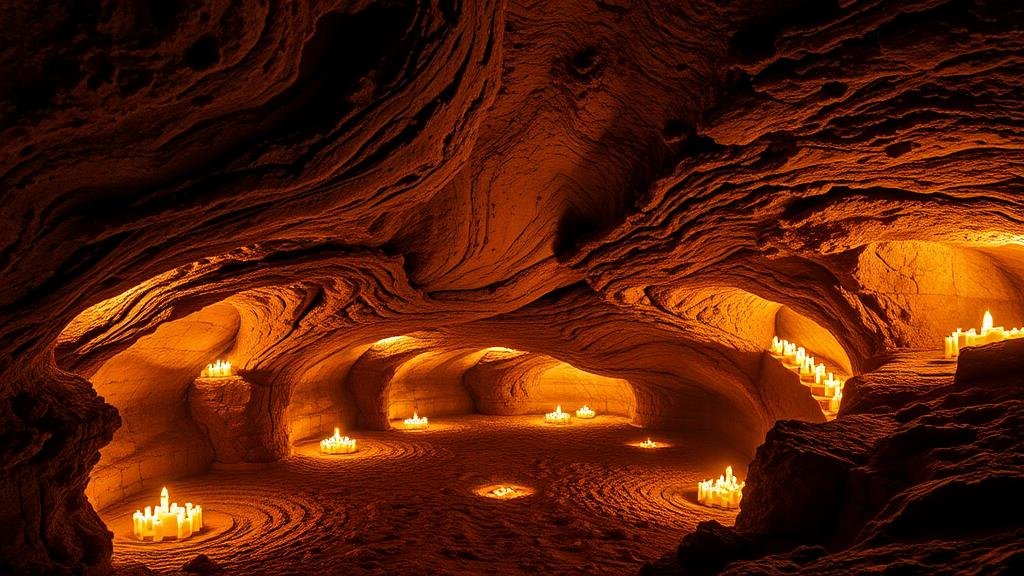Discovering the “Cave of Infinite Candles,” where natural light mimics sacred flames.
Discovering the “Cave of Infinite Candles”
The “Cave of Infinite Candles,” a stunning natural phenomenon located in the heart of the Oaxacan Mountains in Mexico, captivates visitors with its unique interplay of natural light, geological formations, and historical significance. This enchanting cave has become a popular destination for adventurers, historians, and those seeking spiritual enrichment.
A Brief Historical Overview
The cave, known locally as “Cueva de las Velas Infinito,” was first discovered in 1975 by a team of spelunkers exploring the rich network of underground rivers in the region. A multitude of myths and legends have developed around the cave, with many indigenous communities believing it to be a sacred space related to their cultural practices. cave has drawn attention not only for its beauty but also for its archaeological significance, housing various artifacts that provide insight into pre-Columbian life in the area.
The Natural Phenomenon
The most striking aspect of the Cave of Infinite Candles is its incredible lighting conditions. Sunlight enters the cave through small openings, illuminating its walls in a way that mimics the flickering of candles. This optical effect is due to the unique mineral composition of the cave walls, particularly calcite and gypsum, which refract light in mesmerizing patterns. cave is approximately 200 meters in length, with several chambers showcasing various formations.
Symbolism and Spiritual Significance
For many visitors, the cave serves as a site for spiritual reflection. The shifting light creates an ambiance that encourages introspection and meditation. Some communities consider the cave a pilgrimage site, where individuals partake in rituals designed to honor their ancestral spirits. Anecdotal evidence suggests that participants report feelings of renewal and enlightenment following their visits, further solidifying the cave’s role as a place of sacredness.
Visitor Experience
Visitors to the Cave of Infinite Candles can expect a unique journey into the unknown, with guided tours available to enhance the experience. The tours often include:
- In-depth information about the caves geology and history.
- Guided meditative practices and rituals led by local shamans.
In peak seasons, such as summer and the festive months leading up to Day of the Dead (October), the flow of tourists increases significantly. According to local tourism data, approximately 15,000 visitors explore the cave annually, highlighting its growing popularity as a cultural site.
Conservation Efforts
Recognizing the importance of this natural jewel, local authorities and conservationists have initiated efforts to protect the cave from the impacts of increased tourism. Sustainable practices, such as limiting the number of daily visitors and providing educational resources, aim to preserve the cave’s delicate ecosystem. The cave is home to diverse species of bats and unique flora, which rely on the cave for habitat.
Real-World Applications
The Cave of Infinite Candles not only functions as a travel destination but also serves as a case study in sustainable tourism. By balancing the interests of visitors with the need to protect natural resources, the cave exemplifies how communities can manage their cultural and environmental heritage effectively. Educational programs have been developed, fostering a deeper understanding of the caves ecological and historical context among tourists and locals alike.
Actionable Takeaways
For those interested in visiting the Cave of Infinite Candles, here are some beneficial tips:
- Plan your visit during the off-peak season to avoid large crowds and fully immerse yourself in the experience.
- Consider participating in guided meditation sessions or local ritual practices to gain a deeper understanding of the caves cultural significance.
- Support conservation efforts by respecting all signs and guidelines while exploring the site.
To wrap up, the Cave of Infinite Candles is more than just a visual spectacle; it embodies a fusion of natural beauty, cultural heritage, and spiritual significance. As travelers seek deeper connections to the places they visit, the cave stands as a profound reminder of the intricate relationships between people and their environments.



